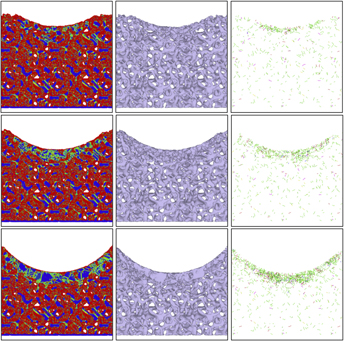Crossref Citations
This article has been cited by the following publications. This list is generated based on data provided by
Crossref.
Ruestes, Carlos J.
Anders, Christian
Bringa, Eduardo M.
and
Urbassek, Herbert M.
2018.
Nanoindentation tests of heavy-ion-irradiated Au foams—molecular dynamics simulation.
Journal of Applied Physics,
Vol. 123,
Issue. 22,
Stuckner, Joshua
and
Murayama, Mitsuhiro
2019.
Mechanical properties of nanoporous gold subjected to tensile stresses in real-time, sub-microscopic scale.
Journal of Materials Science,
Vol. 54,
Issue. 18,
p.
12106.
Aparicio, Emiliano
Millán, Emmanuel N.
Ruestes, Carlos J.
and
Bringa, Eduardo M.
2020.
FoamExplorer: Automated measurement of ligaments and voids for atomistic systems.
Computational Materials Science,
Vol. 185,
Issue. ,
p.
109942.
Beets, Nathan
Stuckner, Joshua
Murayama, Mitsuhiro
and
Farkas, Diana
2020.
Fracture in nanoporous gold: An integrated computational and experimental study.
Acta Materialia,
Vol. 185,
Issue. ,
p.
257.
Kwon, Oh Min
Kim, Jiyeon
Lee, Jinwoo
Kim, Jong-hyoung
Ahn, Hee-Jun
Kim, Ju-Young
Kim, Young-Cheon
and
Kwon, Dongil
2021.
Compressive Properties of Nanoporous Gold Through Nanoindentation: An Analytical Approach Based on the Expanding Cavity Model.
Metals and Materials International,
Vol. 27,
Issue. 10,
p.
3787.
Lionello, D. F.
Ramallo, J. I.
Caro, M.
Wang, Y. Q.
Sheehan, C.
Baldwin, J. K.
Nogan, J.
Caro, A.
Fuertes, M. C.
and
Ruestes, C. J.
2021.
Mechanical properties of Al2O3-functionalized nanoporous gold foams under irradiation.
Journal of Materials Research,
Vol. 36,
Issue. 10,
p.
2001.
Huber, Norbert
2021.
A Strategy for Dimensionality Reduction and Data Analysis Applied to Microstructure–Property Relationships of Nanoporous Metals.
Materials,
Vol. 14,
Issue. 8,
p.
1822.
Klomp, Arne J.
Stukowski, Alexander
Müller, Ralf
Albe, Karsten
and
Diewald, Felix
2021.
Influence of surface stress on the mechanical response of nanoporous metals studied by an atomistically informed continuum model.
Acta Materialia,
Vol. 221,
Issue. ,
p.
117373.
Mathesan, Santhosh
and
Mordehai, Dan
2021.
On the yielding and densification of nanoporous Au nanopillars in molecular dynamics simulations.
Computational Materials Science,
Vol. 191,
Issue. ,
p.
110307.
Valencia, Felipe J.
Ortega, Robinson
González, Rafael I.
Bringa, Eduardo M.
Kiwi, Miguel
and
Ruestes, Carlos J.
2022.
Nanoindentation of nanoporous tungsten: A molecular dynamics approach.
Computational Materials Science,
Vol. 209,
Issue. ,
p.
111336.
Deluigi, O. R.
Valencia, F.
Amigo, N.
Aquistapace, F.
Gonzalez, R. I.
and
Bringa, E. M.
2022.
Atomistic simulations of tensile deformation of a nanoporous high-entropy alloy.
Journal of Materials Science,
Vol. 57,
Issue. 42,
p.
19817.
dos Santos, Gonzalo
Meyer, Robert
Tramontina, Diego
Bringa, Eduardo M.
and
Urbassek, Herbert M.
2023.
Spin-lattice-dynamics analysis of magnetic properties of iron under compression.
Scientific Reports,
Vol. 13,
Issue. 1,
Murayama, Mitsuhiro
and
Stuckner, Joshua
2023.
Dynamic Processes in Solids.
p.
265.
Engelman, Ben
Mathesan, Santhosh
Fedyaeva, Tatyana
Bisht, Anuj
Rabkin, Eugen
and
Mordehai, Dan
2025.
Deformation behavior of nanoporous gold nanoparticles during compression.
Acta Materialia,
Vol. 286,
Issue. ,
p.
120723.
Ruestes, Carlos J.
Farkas, Diana
and
Snyder, Joshua
2025.
Nanoporous metals under extremes.
MRS Bulletin,
Vol. 50,
Issue. 5,
p.
618.
Nguyen, Phu Cuong
Lee, Seungjoon
and
Ryu, Ill
2026.
Dislocation plasticity in porous micropillars under uniaxial loading.
Journal of Materials Science & Technology,
Vol. 258,
Issue. ,
p.
12.



